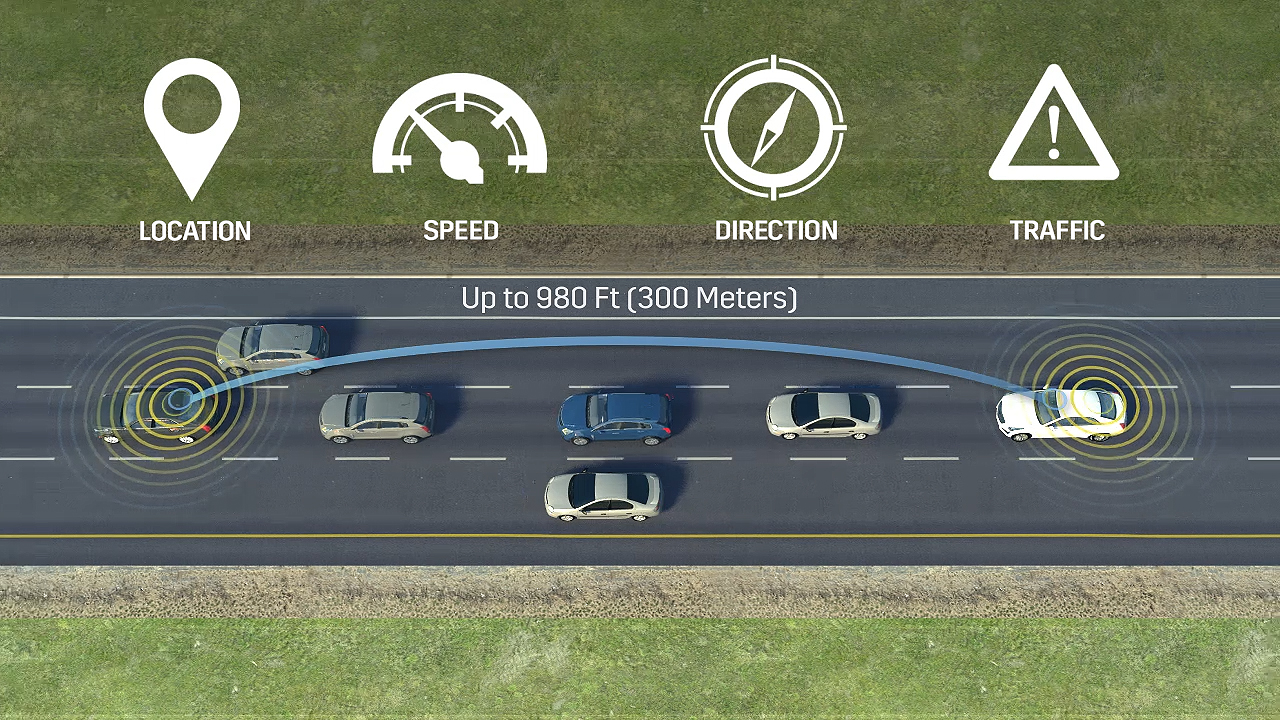Vehicle-to-vehicle (VTV) protocol: Difference between revisions
Mr. MacKenty (talk | contribs) No edit summary |
|||
| (5 intermediate revisions by one other user not shown) | |||
| Line 1: | Line 1: | ||
[[file:Studying.png|right|frame|Case study notes<ref>http://www.flaticon.com/</ref>]] | [[file:Studying.png|right|frame|Case study notes<ref>http://www.flaticon.com/</ref>]] | ||
| Line 16: | Line 12: | ||
== How does it work or a deeper look == | == How does it work or a deeper look == | ||
Vehicle-to-vehicle (V2V) communications comprises a wireless network where automobiles send messages to each other with information about what they’re doing. This data would include speed, location, direction of travel, braking, and loss of stability. Vehicle-to-vehicle technology uses dedicated short-range communications (DSRC), a standard set forth by bodies like FCC and ISO. Sometimes it’s described as being a WiFi network because one of the possible frequencies is 5.9GHz, which is used by WiFi, but it’s more accurate to say “WiFi-like.” The range is up to 300 meters or 1000 feet or about 10 seconds at highway speeds (not 3 seconds as some reports say).ork. <ref> https://www.extremetech.com/extreme/176093-v2v-what-are-vehicle-to-vehicle-communications-and-how-does-it-work </ref> | |||
== Examples == | == Examples == | ||
"Vehicle-to-vehicle communications moved one step closer to reality this week with the Obama administration’s plans to push the technology forward. The February 3rd announcement outlines a set of proposed rules would be announced for comment by the time this administration departs in 2017, with hopes that sometime around 2020, cars will communicate with each other and alert drivers to roadside hazards ahead. What happened this week was a plan by the National Highway Traffic Safety Administration to have a plan." | |||
<ref> https://www.extremetech.com/extreme/176093-v2v-what-are-vehicle-to-vehicle-communications-and-how-does-it-work </ref> | |||
== Pictures, diagrams == | == Pictures, diagrams == | ||
[[File:v2v.jpg]] | |||
== External links == | == External links == | ||
* | * [https://launchforth.io/blog/post/3-reasons-im-skeptical-vehicle-to-vehicle-v2v-communications-would-make-us-safer-drivers/2246/ A skeptics view] | ||
* [https://www.cnet.com/roadshow/news/us-department-of-transportation-hopes-to-mandate-v2v-communications/ v2v mandates] | |||
* to | * [https://en.wikipedia.org/wiki/Vehicle-to-vehicle the obligatory wikipedia article] | ||
* to | |||
== References == | == References == | ||
| Line 44: | Line 35: | ||
[[Category:2018 case study]] | [[Category:2018 case study]] | ||
Latest revision as of 07:00, 14 April 2018

Introduction[edit]
Vehicle-to-vehicle (V2V) is an automobile technology designed to allow automobiles to "talk" to each other. V2V communications form a wireless ad hoc network on the roads. Such networks are also referred to as vehicular ad hoc networks, VANETs. The systems will use a region of the 5.9 GHz band set aside by the United States Congress, the unlicensed frequency also used by WiFi. The US V2V standard, commonly known as WAVE ("Wireless Access for Vehicular Environments"), builds upon the lower-level IEEE 802.11p standard, as early as 2004.
[2]
How does it work or a deeper look[edit]
Vehicle-to-vehicle (V2V) communications comprises a wireless network where automobiles send messages to each other with information about what they’re doing. This data would include speed, location, direction of travel, braking, and loss of stability. Vehicle-to-vehicle technology uses dedicated short-range communications (DSRC), a standard set forth by bodies like FCC and ISO. Sometimes it’s described as being a WiFi network because one of the possible frequencies is 5.9GHz, which is used by WiFi, but it’s more accurate to say “WiFi-like.” The range is up to 300 meters or 1000 feet or about 10 seconds at highway speeds (not 3 seconds as some reports say).ork. [4]
Examples[edit]
"Vehicle-to-vehicle communications moved one step closer to reality this week with the Obama administration’s plans to push the technology forward. The February 3rd announcement outlines a set of proposed rules would be announced for comment by the time this administration departs in 2017, with hopes that sometime around 2020, cars will communicate with each other and alert drivers to roadside hazards ahead. What happened this week was a plan by the National Highway Traffic Safety Administration to have a plan."
Pictures, diagrams[edit]
External links[edit]
References[edit]
- ↑ http://www.flaticon.com/
- ↑ https://en.wikipedia.org/wiki/Vehicle-to-vehicle
- ↑ http://ieeexplore.ieee.org/document/5361174/?reload=true
- ↑ https://www.extremetech.com/extreme/176093-v2v-what-are-vehicle-to-vehicle-communications-and-how-does-it-work
- ↑ https://www.extremetech.com/extreme/176093-v2v-what-are-vehicle-to-vehicle-communications-and-how-does-it-work
